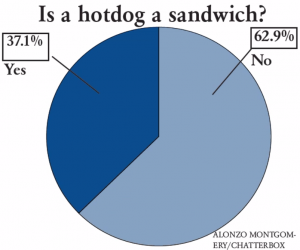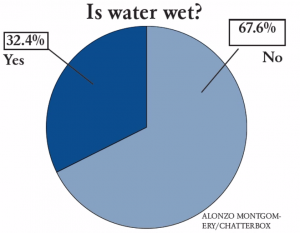Food Controversies
Is water wet? Is a hotdog a sandwich? WHHS students weigh in.
October 9, 2018
For years, people have had at least one of these two age-old debates. And for years these debates have sparked numerous arguments as to what the answer to each is: “is water wet?” and “is a hotdog a sandwich?”
Many people have participated, and many arguments have been provided by your fellow Eagles. WHHS has weighed into the debate, and 67.6 percent of students say no, water isn’t wet.
“If you put water in the ocean, does that make the ocean wet?” Janaya Render, ‘22, said. Render furthered her explanation that “wet means to be saturated or touched with water, so water can’t be wet; it can make other things wet but can’t be wet itself–that’s also like saying is fire burnt.”

But others have said that water is, in fact, wet. “All liquids are wet. When a liquid sticks to something else, it becomes wet. Water sticks to itself, therefore it is wet,” SENIOR Nolan Brown said. Many have argued about these things for a while now. An example of this is scientist/YouTuber The Action Lab.
The Action Lab, a YouTube channel, said that water is wet because there is always something in it, something that makes water stick to itself. The Action Lab even says that a system is never 100 percent water. This means that if we could somehow get 100 percent pure water, then it wouldn’t be called wet.
So is it wet or is it not wet? For that is the question. The answer is yes, water is wet. Because to be wet means that water molecules or another liquid’s molecules have to stick to something. Since water molecules stick to other water molecules, water is by definition wet.
But, there is another question to be asked. Are hot dogs sandwiches? In fact, 62.9 percent of surveyed WHHS students said no, hot dogs are not sandwiches. But some people say yes. Merriam Webster defines a sandwich as “two or more slices of bread or a split roll having a filling in between.” A hot dog bun is a split roll. Ergo, a hot dog, according to Merriam Webster, is a sandwich.
Others say hot dogs are sandwiches as well. “It is in between two pieces of bread. Even if the piece of bread is cut in half it is still a sandwich. Subs are a piece of bread cut in half with things inside of it, and that is still considered a sandwich, which is exactly what a hot dog is,” SENIOR Nick Wheeler said.
This theory is furthered by the explanation that hot dogs are eaten vertically. The bun does not effectively cover the meat like a sandwich does; it partially circles the sausage, while a sandwich would be above and below it, not covering the sides. “Using two pieces of normal bread for a hot dog is not conventional,” Cosette Snyder, ‘20, said.
On the flip side, many have also argued that no, a hot dog is not a sandwich. An example is that “a hot dog is not a sandwich because the bun used is closed on one side. [In] all the sandwiches I’ve eaten, both of the sides of the bread are open,” Sofia Leigh, ‘23, said.

“A sandwich has two different pieces of bread and a hot dog only has one. So therefore it’s not a sandwich, more of a wrap,” James Baur, ‘21, said.
The issues have been fought about for a while. Scientifically, the answer is that water is wet. But people will still have their own thoughts and opinions. You can also look up a definition of a sandwich and see that a split roll would count making hot dogs sandwiches. But people will still have their own opinions. So in conclusion, water is wet and hot dogs are left at the opinions of whoever feels inclined to ask or answer that question.
All views shared in the Opinions section of The Chatterbox belong to their respective authors, and may not represent the views of the publication as a whole.






